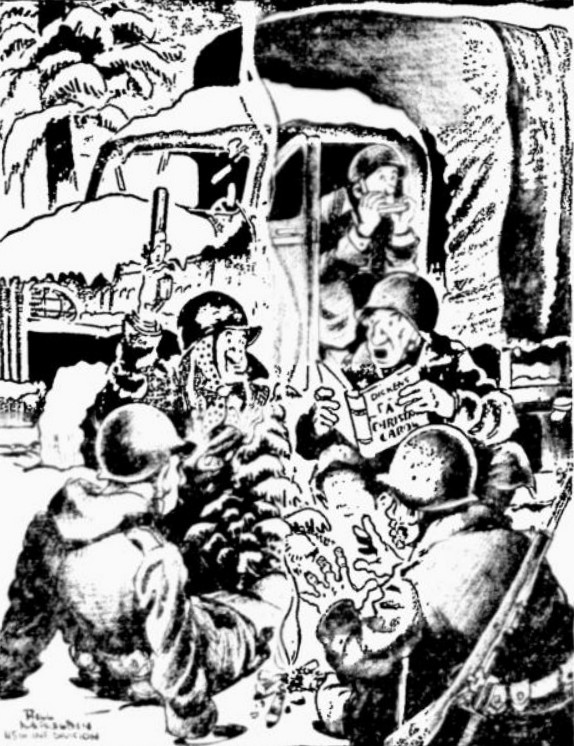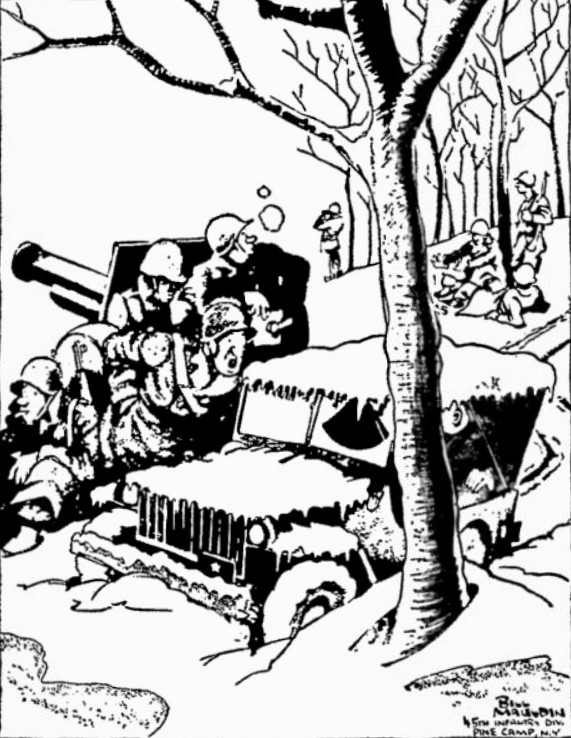The Pittsburgh Press (January 5, 1944)

Roving Reporter
By Ernie Pyle
At the frontlines in Italy – (by wireless)
You have been reading on the papers for weeks about the mountain fighting in Italy, and how some of the troops are so high and remote that they have to be supplied by pack mule.
Well, for the last few days, I have been hanging around with one of these mule outfits.
There is an average of one mule packing outfit for every infantry battalion in the mountains. Some are run by Americans, some by Italian soldiers.
The pack outfit I was with supplied a battalion that was fighting on a bald rocky ridge nearly 4,000 feet high. It fought constantly for 10 days and nights, and when it finally came down, less than a third of the original men were left.
All through those butter days, every ounce of their supplies had to go up to them on the backs of mules and men. Mules took it the first third of the way. Men took it the last bitter two-thirds because the trail was too steep even for mules.
The mule skinners of my outfit were Italian soldiers. The human packers were mostly American soldiers.
The Italian mule skinners were from Sardinia. They belonged to a mountain artillery regiment, and thus were experienced in climbing and in handling mules. They were bivouacked in an olive grove alongside a highway at the foot of the mountain.
Shells scare Italians away
They made no trips in the daytime, except in emergencies, because most of the trail was exposed to artillery fire. Supplies were brought into the olive grove by truck during the day, and stacked under trees. Just before dusk, they would start loading the stuff onto mules.
The Americans who actually managed the supply chain liked to get the mules loaded by dark, because if there was any shelling, the Italians instantly disappeared and you never could find them.
On an average night, the supplies would run something like this – 85 cans of water, 100 cases of K ration, 20 cases of D ration, 10 miles of telephone wire, 25 cases of grenades and rifles and machine-gun ammunition, about 100 rounds of heavy mortar shells, one radio, two telephones, and four cases of first-aid packets and sulfa drugs.
In addition, the packers would load their pockets with cigarettes for the boys on top; also cans of Sterno, so they could heat some coffee once in a while.
Also, during that period, they took up more than 500 of the heavy combat suits we are issuing to the troops to help keep them warm. They carried up cellophane gas capes for some of the men to use as sleeping bags, and took extra socks for the boys too.
Mail most tragic cargo
Mail was their most tragic cargo. Every night they would take up sacks of mail, and every night bring a large portion of it back down – the recipients would have been killed or wounded the day their letters came.
On the long man-killing climb above the end of the mule trail, they used anywhere from 20 to 300 men a night. They rang in cooks, truck drivers, clerks, and anybody else they could lay their hands on.
A lot of stuff was packed up by the fighting soldiers themselves. On the biggest night, when they were building up supplies for an attack, another battalion which was in reserve sent 300 first-line combat troops to do the packing.
Back to the mules again – they would leave the olive grove in bunches of 20, starting just after dark. American soldiers were posted within shouting distance of each other all along the trail, to keep the Italians from getting lost in the dark.
Those guides form a little sidelight that I wish everybody in America who thinks he’s having a tough time in this war could know about.
The guides were men who had fought all through a long and bitter battle at the top of the mountain. For more than a week, they had been far up there, perched behind rocks in the rain and cold, eating cold K rations, sleeping without blankets, scourged constantly with artillery and mortar shells, fighting and ducking and growing more and more weary, seeing their comrades wounded one by one and taken down the mountain.
Finally, sickness and exhaustion overtook many of those who were left, so they were sent back down the mountain under their own power to report to the medics at the bottom and be sent back to a rest camp. It took most of them the better part of a day to get two-thirds of the way down, so sore were their feet and so weary their muscles.
And then – when actually in sight of their haven of rest and peace – they were stopped and pressed into this guide service, because there just wasn’t anybody else to do it.
So, there they stayed, right on the mountainside, for at least three additional days and nights that I know of, just lying miserably alongside the trail to shout in the darkness and guide the mules.
They still had no blankets to keep them warm, no beds but the rocks. And they did it without complaining. The human spirit is an astounding thing.

